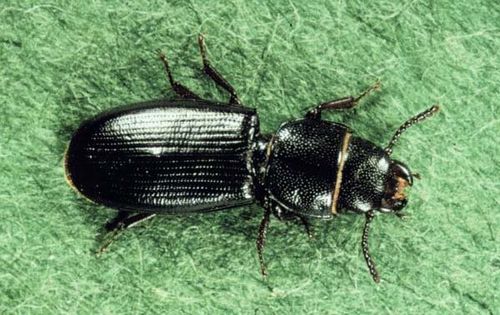Five Insects That Can Destroy Your Grain Stockpile

Pests and rodents are the primary source of destruction of long-term stores of grain, corn and rice aside from moisture. In fact, some estimates suggest that up to a third of all stored products are destroyed by insects world wide every year. Let’s take a look at the top five threats that commonly infest stored dried-goods in the United States.
Weevils

Out of all of the insects that can decimate food stores, the weevils are the most dangerous and prolific. Their primary threat comes from chewing and boring their way through kernels and laying eggs inside. The larvae feed on the nutrients in the grains and render them useless for human consumption. Some weevils can lay 500 or more eggs in their lifetime, and this translates into a lot of grain that gets lost from egg-laying. Additionally, some weevils do not eat through healthy, hard grains, but penetrate softer products or ones that were already compromised by other insects.
Grain Borers

Grain borers are small beetles that chew their way through grains and also lay eggs. The eggs then develop inside of the grain. Once hatched, the larvae eat the flour that is created from the adults who bore the holes in other shells. This process is repeated as populations increase and adults seek new grains to lay eggs. Grain borers thrive in warm climates, and grain stores in the South are particularly vulnerable. However, due to global and interstate commerce, their presence has been long-established and widespread. There are many different types of grain borers, and some target wheat whereas others thrive on corn.
Moths

There are a variety of species of moths that attack grain, corn and flour. They can be problematic on crops that are growing, kernels that are stored or milled flour. This makes them a very wide-spread threat that impacts everyone from large food storage companies and warehouses to the homesteader who is maintaining a long-term stockpile.
The most destructive of all moths is the Angoumois grain moth, and it attacks all cereal grains and corn. It lays eggs on growing heads and kernels as well as in stored products. The eggs hatch, burrow into the grain and consume what is inside. They are found in most grain-producing parts of the country, and they can survive in stored products in cooler areas as well. Rice moths are equally destructive in rice crops, and this can include those produced domestically as well as imports.
Beetles

The Cadelle beetle is one of the most destructive of all of the flour and grain beetles, and is also one of the largest. It spawns cocoons and thrives in storehouses and processing facilities. They also have a tendency to jump from grain to grain, devouring the kernels for food. They also live for a very long time, sometimes in excess of two years, which dramatically enhances their destructive potential. They are also found all over the United States. Females lay their eggs in timbers or cracks and crevices of storage bins and transportation containers before hatching and then spreading to the food product.
The Sawtoothed Grain Beetle is very small, but incredibly destructive to almost all grain and dried food products, including dehydrated vegetables and nuts. They can live for up to a year, lay more than 600 eggs and larvae as well as adults jump from kernel to kernel in order to feed. They are also found in storehouses across the United States where they end up being distributed in contaminated products across the country.
Mealworms

Mealworms are not technically worms, rather larvae from a wide-range of beetle species. They like to hide in dark and moist places, particularly in grain storage areas. They eat everything from cereal grains to flour and corn, and tend to me most active at night. Some species prefer to eat whole grains whereas others eat the dusty remnants of waste products. Others simply feed on microorganisms on top of grains as well.
Keep in mind that these are just a few of the most prolific pests out there, but there are thousands more that can be destructive to your long-term food stockpile. Make sure that you are properly storing your food, taking care to inspect products before packaging, and periodically checking your products for signs of invasions. The most obvious sign will be holes in the packaging, small insects crawling in and out of plastic bins or their presence on or around sacks. The only real way to control infestations is to be vigilant and careful, and you want to make sure that you nip any problems in the bud before they snowball into a threat to your food supply.
